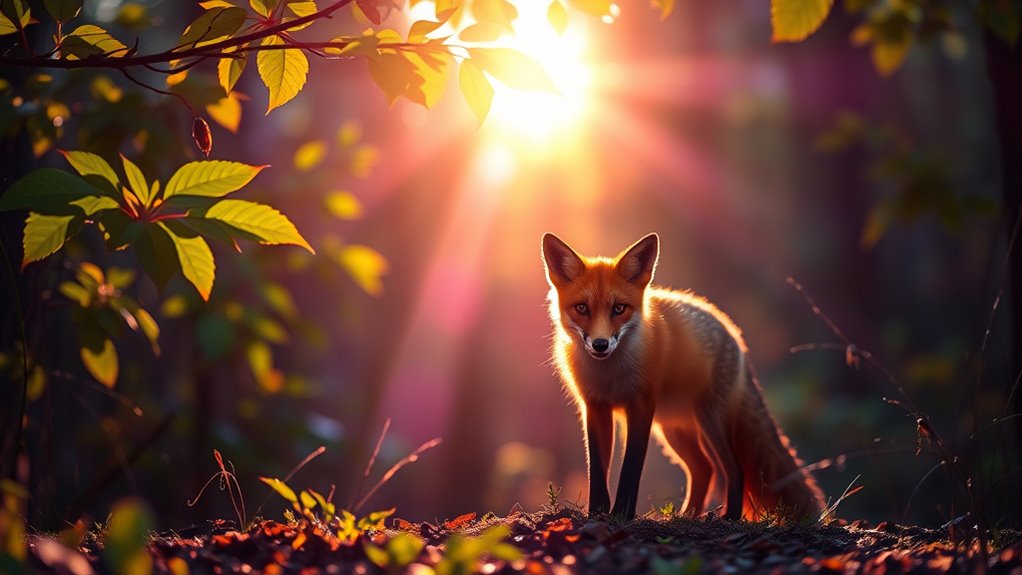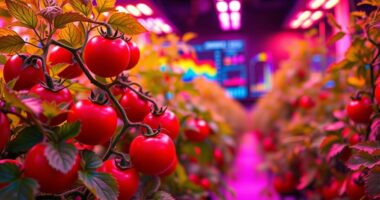Light wavelengths are essential for shaping animal behavior by regulating their internal clocks, sensory perceptions, and physiological functions. Different animals respond to specific light colors and intensities, which influence activity patterns, migration, reproductive timing, and safety. For example, certain wavelengths help aquatic animals navigate or hunters detect prey. Understanding how these wavelengths affect them can reveal much about their survival strategies. Keep exploring to uncover how photobiology impacts animals across the natural world.
Key Takeaways
- Different animal species perceive specific light wavelengths, influencing behaviors like navigation, hunting, and communication.
- Light wavelengths regulate circadian rhythms, affecting sleep-wake cycles and activity patterns.
- Variations in color and intensity of light can trigger reproductive behaviors and social interactions.
- Certain wavelengths, such as UV or infrared, are critical for species-specific environmental cues.
- Understanding light’s wavelength effects helps optimize animal welfare and behavior management.

Photobiology, the study of how light influences living organisms, plays a vital role in shaping animal behavior. When you consider how animals respond to their environment, you realize that light is more than just illumination; it’s a key signal that guides daily activities. One of the most significant ways light impacts animals is through circadian rhythms—those internal clocks that regulate sleep-wake cycles, feeding, and other behaviors. Light cues, especially the natural progression of daylight, synchronize these rhythms, ensuring animals are active during the day and rest at night. If the light environment changes, such as in urban areas with artificial lighting, it can disrupt these rhythms, leading to changes in behavior, health, and survival.
Light influences animal behavior by regulating internal clocks and responding to environmental cues.
Your understanding of visual perception is also crucial here. Animals perceive light differently depending on their visual systems, which are tuned to specific wavelengths. For example, some species see ultraviolet light, while others are sensitive to infrared. This variation affects how animals interpret their surroundings, find food, detect predators, or communicate. When light of particular wavelengths reaches their eyes, it triggers specific responses—like a bird recognizing the quality of daylight for migration or a predator using low-light vision to hunt at dusk. By tuning into different wavelengths, animals can adapt their behaviors to optimize survival, whether that means avoiding predators, seeking mates, or navigating their habitats.
You might not realize it, but the color and intensity of light influence not just what animals see but also how they behave. For instance, blue and green wavelengths penetrate water more effectively, guiding fish and marine mammals during foraging or migration. In terrestrial settings, red light often signals dusk or dawn, prompting animals to prepare for activity or rest. As you observe animals in their natural habitats, you notice how their behavior shifts with changes in light quality and quantity. Their activity patterns, social interactions, and even reproductive strategies can hinge on subtle variations in light wavelengths.
Understanding photobiology’s role in animal behavior helps you appreciate the complexity behind daily life in the animal kingdom. Light doesn’t just illuminate their world—it actively shapes when they wake, hunt, breed, and rest. Recognizing the importance of circadian rhythms and visual perception underscores how vital the right wavelength of light is for their well-being. Additionally, advances in photobiological research continue to reveal how specific wavelengths influence physiological processes in animals. Whether in the wild or human-influenced environments, light continues to be a powerful influence, guiding animal behavior in ways you might not have fully appreciated before.
Frequently Asked Questions
How Do Artificial Light Sources Influence Animal Circadian Rhythms?
Artificial light sources, like streetlights and screens, disrupt your animals’ natural circadian rhythms by introducing light pollution. This excessive or poorly timed artificial lighting can confuse their biological clocks, affecting sleep, feeding, and mating behaviors. You might notice animals becoming more active at unusual times or experiencing stress. To help, reduce unnecessary artificial lighting, especially at night, to allow animals to maintain their natural cycles and overall health.
Can Animals Perceive UV or Infrared Light?
You might wonder if animals can perceive UV or infrared light. Many animals have a broader visual spectrum than humans, allowing them to detect UV light, which aids in navigation or mate selection. Some species, like snakes, sense infrared for hunting. Their sensory perception extends beyond human capabilities, enabling them to detect wavelengths outside our visible spectrum, which influences their behavior and survival strategies markedly.
How Does Light Pollution Impact Nocturnal Animal Behavior?
Ever wonder how all that urban glow and sky glow affect nocturnal animals? Light pollution disrupts their natural behaviors by confusing their navigation, hunting, and mating routines. It can reduce their ability to see prey or predators, leading to population declines. Do you realize how our bright city lights may unintentionally threaten these creatures? Protecting dark skies helps preserve their natural rhythms and ecosystems.
Are There Species That Use Light for Navigation or Communication?
You’ll find that many species use light for navigation or communication. For example, some animals rely on bioluminescent communication to attract mates or ward off predators in dark environments. Others, like migratory birds and sea turtles, follow migratory light cues to find their way across vast distances. These light signals are vital for their survival, helping them navigate and communicate effectively despite challenging conditions.
How Might Climate Change Affect Natural Light Exposure for Animals?
Imagine animals as sailors steering a vast sea of light. Climate change acts like a storm, disrupting their usual light cues. You’ll see their voyage affected as light availability shifts, challenging their climate adaptation. Reduced or altered sunlight patterns can confuse navigation and communication, making survival harder. As the environment changes, these creatures must find new ways to read the sky’s signals, adjusting their behavior to the evolving light landscape.
Conclusion
By understanding how different light wavelengths influence animal behavior, you gain insight into nature’s delicate balance. Remember, a little light can go a long way—like the saying, “Every cloud has a silver lining.” When you consider how light shapes life around you, you’ll see that even the smallest change can make a big difference. So, stay curious and keep exploring how light continues to influence the world in ways you never imagined.









